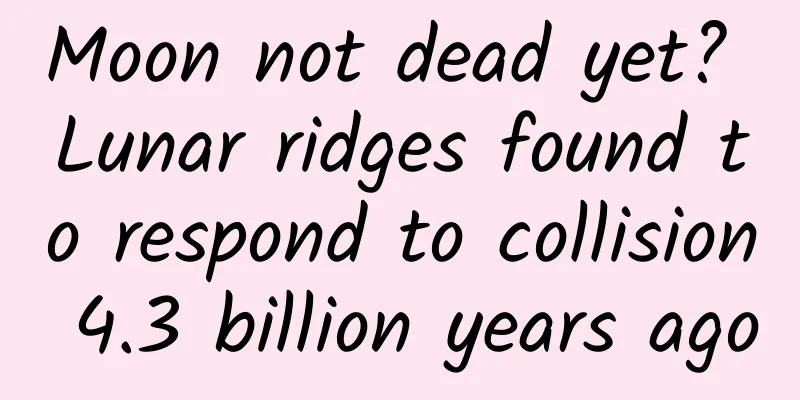Moon not dead yet? Lunar ridges found to respond to collision 4.3 billion years ago

|
[Mobile software: Bo Ke Yuan] Scientists have discovered a ridge system across the near side of the moon, covered with newly exposed boulders. These ridges may be evidence of active lunar tectonic processes or the echo of an impact that almost broke the moon apart long ago. Peter Schultz, a co-author of the study and a professor in the Department of Earth, Environmental and Planetary Sciences at Brown University, said: "There is a hypothesis that the moon has long been dead, but we keep finding that this is not the case. The research was published in the journal Geology. The moon may still be creaking and cracking, as evidence can be seen in these ridges, as seen in the image below. Much of the lunar surface is covered in regolith, a layer of powdery ground rock formed by constant bombardment from tiny meteorites and other impactors. Areas of regolith without exposed lunar bedrock are extremely rare. But Adoma Valantinas of the University of Bern, who led the study while a visiting scholar at Brown University, used data from NASA's Lunar Reconnaissance Orbiter (LRO) to discover strange exposed spots in and around the lunar maria (large dark areas on the left side of the moon). Image: Infrared light (upper left) and other images from NASA's Lunar Reconnaissance Orbiter show strange new exposed spots on the moon, suggesting an active tectonic process. Exposed patches on the lunar surface are relatively short-lived because the buildup of wind layers is constantly happening. So when researchers see them, some explanation is needed as to how and why they are exposed in certain places. The Diviner instrument on the Lunar Reconnaissance Orbiter was used in this study, which measures the temperature of the lunar surface. Just as concrete-covered cities on Earth retain more heat than rural areas, exposed bedrock and patchy surfaces on the Moon stay warmer during the lunar night than regolith-covered surfaces. Using nighttime observations from Diviner, Valantinas discovered more than 500 patches of exposed bedrock on narrow ridges, following a pattern across the maria on the lunar near side. Several ridges covered with exposed bedrock had been seen before, but these were at the edges of ancient lava-filled impact basins and could be explained by continued subsidence caused by the weight of the lava fill. But the new study found that the most active ridges are associated with a mysterious system of tectonic features (ridges and faults) on the lunar far side, unrelated to the lava basins and other young faults that crisscross the highlands. The distribution found here requires a different explanation. The researchers tabulated all the exposures shown in the Diviner data and found an interesting correlation. In 2014, NASA's GRAIL mission discovered a network of ancient cracks in the lunar crust. These cracks became channels for magma to flow into the lunar surface to form deep intrusions. The study showed that the blocky ridges seem to be almost exactly the same as the deep intrusions revealed by GRAIL. It's almost a one-to-one correlation. What we see is an ongoing process driven by the lunar interior. The researchers believe that ridges above these ancient intrusions are still rising upward. The upward movement breaks up the surface, draining regolith into cracks and voids, exposing the massifs. Because exposed spots on the Moon are quickly covered over, this breakup must be new and could even be ongoing today, and an active left-sided tectonic system. The researchers believe these systems actually became active billions of years ago with a huge impact on the far side of the Moon. In previous studies, the researchers proposed this impact: The impact formed the 1,500-mile-long South Pole-Aitken Basin and shattered the interior on the opposite side, the left side facing Earth. Magma then filled these fractures and dominated the pattern of dikes detected by the GRAIL mission, with blocky ridges now tracking ongoing adjustments along these ancient weaknesses. It looks like the ridges are responding to something that happened 4.3 billion years ago, and giant impacts can have long-lasting effects. The Moon has a long memory, and what we see on the lunar surface today is a testament to its long memory and the secrets it still holds. Bo Ke Yuan | Research/From: Brown University The research was published in the journal Geology BoKeYuan|Science, technology, research, popular science Follow [Bokeyuan] to see more beautiful cosmic science |
Recommend
Why are the seats in the subway designed to be slippery?
One minute with the doctor, the postures are cons...
Xianyu Taobao sells Apple WeChat Beans recharge project, one order profit 5 yuan! Information gap Xiaobai part-time project
Xianyu Taobao sells Apple WeChat Beans recharge p...
How should operations perform user segmentation? 8 steps to clear your mind
If the thinking section gives us the angle to thi...
The charm of Riana Iyengar Yoga
Introduction to Riana Iyengar Yoga's charming...
Four ways to update UI asynchronously on Android
As we all know, due to performance requirements, ...
"How did a deer from across the ocean end up on our national emblem?"
This is the national emblem of Antigua and Barbud...
Uncover the iOS apps that only Apple employees can use
Currently, Apple's App Store has nearly 1.3 m...
Technology News | Guangdong Province achieves “high-speed rail connection between all cities”
【Today’s cover】 Wuyi Mountain in winter is full o...
9 Interaction Differences Between iOS and Android That Even Experts Can Easily Overlook
Nowadays, most PMs/interaction/UI designers use i...
How to reduce advertising costs on Facebook ads!
Facebook uses an auction system to determine whic...
The history of smallpox eradication: You should know
As one of the viruses that has completely disappe...
Cats in my rural hometown catch snakes and eat them in summer. Are cats really not afraid of snakes?
Cats and snakes have one thing in common, which i...
Who did you learn the secrets of attracting new customers?
In recent years, competition in the online educat...
Nature: A nearly perfect human blastocyst model was born, and women are expected to have reproductive rights
Reproduction has been one of the most important l...
Should I run through the airport or arrive 2 hours early? Economist: Arriving early is a waste of life
Today is the first day of the May Day holiday. I ...









